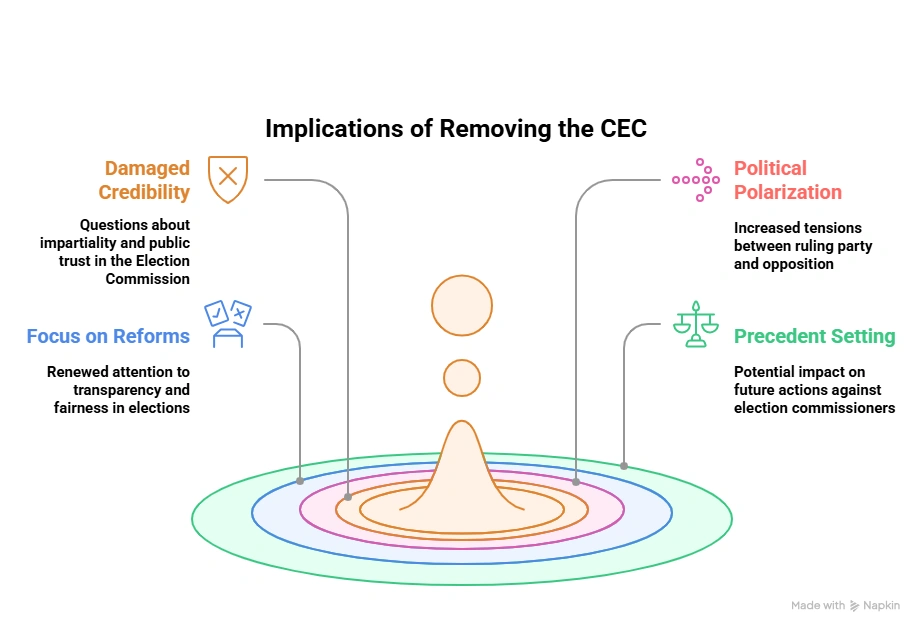Paper: GS-II, Subject: Polity, Topic: Institutions, Issue: Removal of Chief Election Commissioner (CEC)
Context:
The INDIA bloc is considering moving a motion to remove Chief Election Commissioner Gyanesh Kumar, after he accused the Opposition of “spreading misinformation.”
About Election Commission of India (ECI)
- Establishment: The ECI is an autonomous permanent constitutional authority established in 1950 for administering election processes in India.
- The Election Commission operates under Article 324 (Part XV of the Constitution) and the subsequently enacted Representation of the People Act.
- Elections: The body administers elections to the
- Lok Sabha
- Rajya Sabha
- State Legislative Assemblies
- Office of the President
- Office of the Vice President
Composition: Originally the commission had only a Chief Election Commissioner (CEC).
Since 1993, it has become a multi-member commission with Chief Election Commissioner and two Election Commissioners (ECs).
- Article 324(2) empowers the President of India to fix from time to time the number of Election Commissioners other than the CEC.
- If the CEC and other ECs differ in opinion on any matter, such matter shall be decided by according to the opinion of the majority.
- Appointment: The President appoints Chief Election Commissioner and Election Commissioners.
- Tenure: They have tenure of 6 years, or up to the age of 65 years, whichever is earlier.
- They enjoy the same status and receive salary and perks as available to Judges of the Supreme Court of India.
What is the removal procedure for Election Commissioners?
- Grounds: The chief election commissioner has security of tenure and can be removed from the office in a manner similar to a judge of the Supreme Court.
- The grounds are either proved misbehavior or incapacity.
| What is the Procedure for Removal of a Judge? Constitutional provisions: Under Articles 124 and 217 of the Indian Constitution, a Supreme Court or High Court judge can be removed by the President on grounds of ‘proved misbehaviour’ or ‘incapacity’. The motion must be passed in both Houses of Parliament: By a majority of the total membership of the House, and by a two-thirds majority of the members present and voting in the same session (special majority). The procedure for removal of judges is elaborated in the Judges (Inquiry) Act, 1968, which requires: A motion for removal is to be signed by at least 50 members in the Rajya Sabha or 100 members in the Lok Sabha. The Chairman of the Rajya Sabha or the Speaker of the Lok Sabha has the discretion to admit or reject the motion after consultation. If admitted, a three-member committee is constituted, comprising: A Supreme Court Judge, A High Court Judge, and A distinguished jurist. The committee investigates the allegations. If the judge is cleared of misconduct or incapacity, the motion is dropped and not pursued further. If the committee finds the judge guilty of misbehaviour or incapacity, the report is tabled in both Houses of Parliament, where the motion must be passed by a special majority. |
Removing Procedure for Chief Election Commissioner:
- Based on any complaints, an inquiry is initiated. The inquiry report is laid before both houses of the Parliament for voting.
- The President is empowered to remove the Chief Election Commissioner on the basis of a resolution passed by both Houses of Parliament with the special majority (majority of two-thirds members present and voting supported by more than 50% of the total strength of the house).
- Removal of Other Commissioners: Other election commissioners cannot be removed from office except on the recommendation of the chief election commissioner.

The INDIA bloc’s potential motion against Chief Election Commissioner highlights growing tensions over electoral integrity. The outcome could significantly impact public trust in the Election Commission and the fairness of future elections in India.
La Excellence IAS Academy, the best IAS coaching in Hyderabad, known for delivering quality content and conceptual clarity for UPSC 2025 preparation.
FOLLOW US ON:
◉ YouTube : https://www.youtube.com/@CivilsPrepTeam
◉ Facebook: https://www.facebook.com/LaExcellenceIAS
◉ Instagram: https://www.instagram.com/laexcellenceiasacademy/
GET IN TOUCH:
Contact us at info@laex.in, https://laex.in/contact-us/
or Call us @ +91 9052 29 2929, +91 9052 99 2929, +91 9154 24 2140
OUR BRANCHES:
Head Office: H No: 1-10-225A, Beside AEVA Fertility Center, Ashok Nagar Extension, VV Giri Nagar, Ashok Nagar, Hyderabad, 500020
Madhapur: Flat no: 301, survey no 58-60, Guttala begumpet Madhapur metro pillar: 1524, Rangareddy Hyderabad, Telangana 500081
Bangalore: Plot No: 99, 2nd floor, 80 Feet Road, Beside Poorvika Mobiles, Chandra Layout, Attiguppe, Near Vijaya Nagara, Bengaluru, 560040

